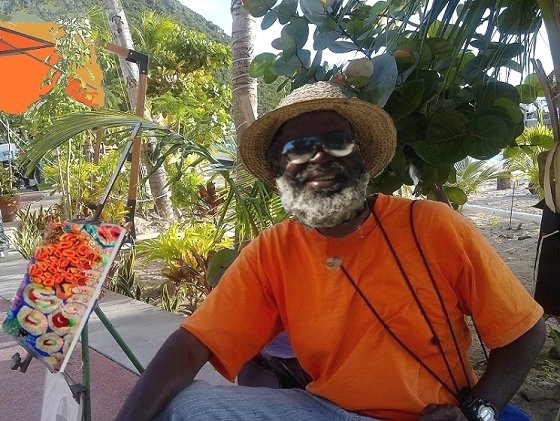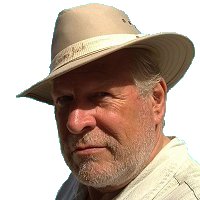|
|
St.Tosia's Art Scene
Duncan La Mar is a well-known painter on St.Tosia. Most of his daytime Duncan spends on the Kaya Loco Strip, the boulevard where creativity and entertainment are embraced with
all oddities. Around ten in the morning, he toddles along the Kaya Loco boulevard pulling his cart with the two scavenged bicycle wheels. On
the plywood cargo bed is all the equipment to set up the joint that he calls his mobile 'en plein air' art studio. The easel, a bar stool,
a sun umbrella and a large utensil box are all strapped down by bungee cords. Duncan usually sets up on the stone wall bordering the golden
beach in the stretch between the "Windhole Resort and Beach Hotel" and the marina of the "Puerto Olvidar Imperial Yacht Club". It is a prominent
location where the lightly dressed eye candy promenades with big sunglasses and their noses in the air, while enjoying the attention they get
from the million dollar troopers who on their turn enjoy the sexy vibes.
![]()
| Duncan La Mar |
|
 |
Duncan unfolds the sun umbrella which shows a bit of wear and tear on the faded orange colored canvas that once must have been as bright as the
blossoms of the island's flamboyant trees. Under the sunshade he opens up the tripod easel and at the cross bar he attaches a broken clothes
hanger with a roll of toilet paper that he uses to clean his brushes. A linen canvas is put on the easel . From the box on the cart he takes
the brushes and tubes of oil paint that he needs for creating a new piece of art and puts them on the paint station console of the three
legged art facilitation apparatus. As he positions the barstool in front of his workstation a voice from behind inquires:
"Hey Picasso, another day of inspired hard labor?"
Without turning around Duncan knows that it is Constable Fushkin doing his rounds and looking for a bit of a handout to fix up his humble salary.
The artist grabs in his pocket where he has a 5 dollar bill ready for this daily corruption routine.
"Here lawman," he says as he hands him the money, "You would be the perfect motivation to create a dark piece of art and call it 'Evil in Paradise'".
Fushkin has no understanding of fine arts and no clue of what Duncan is referring to. With a big dumb and dirty grin and in an attempt to come
over as having a sense of humor he asks sarcastically:
"Need a receipt for your accounting?"
"Beat it man, beat it," Duncan responds as he is sorting his paint brushes and he mumbles for himself: "You distort the vision I have for my next
brilliant and astonishing creation."
Duncan is perfectly happy not doing a whole lot. He believes that freedom includes freedom to do nothing. He also believes that freedom is to do
things his own way.
"It's all a 'whim', man! I do my own thing and paint badly but I just pretend that it is my style. Oh, It's a fact man, it takes courage to
paint the way I do. It's a fact man!"
To Duncan 'color felt' is nourishment and the messenger of illumination; color is his language and color
abstraction is his lingo whereby differentiation is used to shape the conceptual reflection of the moment; a pictorial diary that inspires him
to capture the ever-present storyline of daily life in St.Tosia.
"I do things with paint that no one asks me to do, and no one would really want it, but the well-heeled socialites tell each other that they
ought to have it. It's a fact man, it's a fact".
While most of the members of the artistic community on St.Tosia are struggling to eke out an existence, Duncan is doing very well painting his
pictorial quirky 'whim' in bold luminous cadmium green, red, orange and yellow colors, inspired and nourished by the tropical Caribbean
surroundings. Almost flagrant, his art sparks with life, engaging the senses of the viewer.
After sunset Duncan packs his easel, sunshade, bar stool, and the art utensils box on his cart, straps them down with the bungee cords and grabs
the cart by the hinge and tows it to the "Hakuna Matata Shack" at the East end of the Kaya Loco strip, the hang-out of all artists. In tune with
the meaning of the Swahili phrase Hakuna Matata, akin to "don't worry be happy", it is a crazy, funky fun place and one of the hottest social
scenes for marginalized and impoverished artists, writers, journalists, and actors gathering round and arguing fueled by either intellect or
alcohol. There are two elements at least, that seem essential to them. The first is devotion or addiction to art or some form of creativity;
the other is poverty. They take pleasure in practicing an unconventional lifestyle in the company of like-minded artistic talents who are
untroubled by the disapproval of society. Without exception, whether wannabe artists who lack the X factor or established successful
creative performers, they all enjoy being part of the Caribbean zest of life.
![]()
The Hakuna Matata's walls are littered with a collection of artworks of artists who couldn't pay their bill. It would make art lovers and
collectors drool with envy. The pieces are held until the artist can pay or until someone would buy it, whatever comes first. The scarce light
of flickering candles and oil lamps give the accommodation an aromatic ambiance. The center piece of the lounge room is "Ye Old Winston",
the round mahogany debate table where the torchbearers of conservative resentment can discuss in a fact-free zone amid a fog of double-talk
which represents the spirit and freedom of thought and speech. It is the meeting point where unusual ideas are hatched and mulled over and
inspiration is a gratification.
Of course, that inspiration comes in many forms to the individual liking but inspiration is a topic of endless discussions which give the
gathered artists the strength to continue when they may get tired or burned out and therefore they believe that debating and arguing at
"Ye Olde Winston" is meaningful. Every evening there is a mélange gathering of minds. Just to name a few:
Jean Baptiste Mallau is the poet who came to St,Tosia to 'sin disgracefully' and write inspirational poems. He believes that the root of
all inspiration is the idea that nothing is complete without trying anything at least once and only then his life will become meaningful. "Joie
de Vivre" is his trade mark. It is common knowledge that members of the opposite gender prevail among the admirers of his poetry and they seem
to cannot get enough of his dreamy phrasing and romantic rhyming in the tropical island nights.
Lord Bliss is the singing and songwriting "Soul of St.Tosian Calypso", a former auto mechanic and specialist in fixing tires, who turned itinerant
vocalist. He is one of the most prolific musical performers in the Caribbean. At sixty-six he remains as committed to his musical craft as
he was young when he first devoted himself to a life of melodic expression.
Jahi Kamanda is a wannabe play writer and the stereotype of the struggling and starving artist who believes that life is an exhausting amount of
work and only inspirational ideas can help renew himself to complete his ever unfinished series of theater play fantasies. To make ends meet,
on Saturday nights, he plays the piano in the bar of the "Casa Rosso" house of ill repute.
Dick Doherty, the once technical writer of NASA who switched to writing columns for a gossip boulevard magazine back home, says that for him
inspiration is knowing that what he does matters deeply to the universe and his observations and comments in the dialogs are often as from an
astral flying object of a third kind.
And then there is Alvaro Mantaquin, who is dressed ragged as a cocklebur. He is devoted to a simple life of 'genuine focus' and finds inspiration
in uncorking bottles and to become filled with strength and vigor to fulfill his life's purpose to paint overlapping washes of color that are
sumptuous and create intensification and movement.
In the "Hakuna Matata Shack" of St.Tosia there is no end to discovering the mystery that leads to experiences which draw to a higher
understanding and consciousness of art and its creators.
Cdr. Bud Slabbaert
|
 |
|
|
|